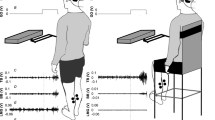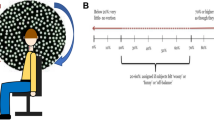Abstract
Short lateral head accelerations were applied to investigate the recruitment properties of the reflexes underlying the earliest ocular and cervical electromyographic reflex responses to these disturbances. Components of both reflexes are vestibular dependent and have been termed “ocular vestibular evoked myogenic potentials” and “cervical vestibular evoked myogenic potentials”, respectively. Previous investigations using a unilateral vestibular stimulus have indicated that some but not all these vestibular-dependent reflexes show a simple power law relationship to stimulus intensity. In particular, crossed otolith-ocular reflexes showed evidence of an inflection separating two types of behaviour. The present stimulus acts bilaterally, and only the earliest crossed otolith-ocular reflex, previously shown to have a strictly unilateral origin, showed evidence of an inflection. Reflex changes in ocular torsion could, in principle, correct for the changes associated with translation for an elevated eye, but our findings indicated that the responses were consistent with previous reports of tilt-type reflexes. For the neck, both vestibular and segmental (muscle spindle) reflexes were evoked and followed power law relationships, without any clear separation in sensitivity. Our findings are consistent with previous evidence of “tilt-like” reflexes evoked by lateral acceleration and suggest that the departure from a power law occurs as a consequence of a unilateral crossed pathway. For the neck, responses to transients are likely to always consist of both vestibular and non-vestibular (segmental) components. Most of the translation-evoked ocular and cervical reflexes appear to follow power law relationship to stimulus amplitude over a physiological range.






Similar content being viewed by others
References
Agrawal Y, Bremova T, Kremmyda O, Strupp M, MacNeilage PR (2013) Clinical testing of otolith function: perceptual thresholds and myogenic potentials. J Assoc Res Otolaryngol 14:905–915
Angelaki DE (2004) Eyes on target: what neurons must do for the vestibuloocular reflex during linear motion. J Neurophysiol 92:20–35
Angelaki DE, McHenry MQ (1999) Short-latency primate vestibuloocular responses during translation. J Neurophysiol 82:1651–1654
Angelaki DE, McHenry MQ, Dickman JD, Perachio AA (2000) Primate translational vestibuloocular reflexes. III. Effects of bilateral labyrinthine electrical stimulation. J Neurophysiol 83:1662–1676
Aw ST, Todd MJ, McGarvie LA, Migliaccio AA, Halmagyi GM (2003) Effects of unilateral vestibular deafferentation on the linear vestibulo-ocular reflex evoked by impulsive eccentric roll rotation. J Neurophysiol 89:969–978
Baloh RW, Beykirch K, Honrubia V, Yee RD (1988) Eye movements induced by linear acceleration on a parallel swing. J Neurophysiol 60:2000–2013
Bronstein AM, Gresty MA (1988) Short latency compensatory eye movement responses to transient linear head acceleration: a specific function of the otolith-ocular reflex. Exp Brain Res 71:406–410
Bush GA, Miles FA (1996) Short-latency compensatory eye movements associated with a brief period of free fall. Exp Brain Res 108:337–340
Colebatch JG, Rothwell JC (2004) Motor unit excitability changes mediating vestibulocollic reflexes in the sternocleidomastoid muscle. Clin Neurophysiol 115:2567–2573
Crane BT, Tian J, Wiest G, Demer JL (2003) Initiation of the human heave linear vestibulo-ocular reflex. Exp Brain Res 148:247–255
Curthoys IS, Kim J, McPhedran SK, Camp AJ (2006) Bone conducted vibration selectively activates irregular primary otolithic vestibular neurons in the guinea pig. Exp Brain Res 175:256–267
Dennis D, Govender S, Chen P, Todd NP, Colebatch JG (2014) Differing response properties of cervical and ocular vestibular evoked myogenic potentials evoked by air conducted stimulation. Clin Neurophysiol, in press: doi 10.1016/j.clnph.2013.11.001
Dieterich M, Bense S, Lutz S, Drzezga A, Stephan T, Bartenstein P, Brandt T (2003) Dominance for vestibular cortical function in the non-dominant hemisphere. Cereb Cortex 13:994–1007
Ferman L, Collwijn H, Van der Berg AV (1987) A direct test of Listing’s Law—II. Human ocular torsion measured under dynamic conditions. Vision Res 27:939–951
Fernández C, Goldberg JM (1976) Physiology of peripheral neurons innervating otolith organs of the squirrel monkey. II. Directional selectivity and force-response relations. J Neurophysiol 39:985–995
Gardner MJ, Altman DG (1989) Statistics with confidence. British Medical Journal, London
Gellman RS, Carl JR, Miles FA (1990) Short latency ocular-following responses in man. Vis Neurosci 5:107–122
Goldberg JM, Cullen KE (2011) Vestibular control of the head: possible functions of the vestibulocollic reflex. Exp Brain Res 210:331–345
Govender S, Colebatch JG, Rosengren SM (2009) The effect of gaze direction on the ocular vestibular evoked myogenic potential produced by air-conducted sound. Clin Neurophysiol 120:1386–1391
Govender S, Rosengren SM, Todd NP, Colebatch JG (2011) Ocular vestibular evoked potentials produced by impulsive lateral acceleration in unilateral vestibular dysfunction. Clin Neurophysiol 122:2498–2504
Halmagyi GM, Yavor RA, Colebatch JG (1995) Tapping the head activates the vestibular system: a new use for the clinical tendon hammer. Neurology 45:1927–1929
Hasan Z, Houk JC (1975) Transition of sensitivity of spindle receptors that occurs when muscle is stretched more than a fraction of a millimeter. J Neurophysiol 38:673–689
Honeycutt CF, Nardelli P, Cope TC, Nichols TR (2012) Muscle spindle responses to horizontal support surface perturbation in the anesthetized cat: insights into the role of autogenic feedback in whole body postural control. J Neurophysiol 108:1253–1261
Iwasaki S, McGarvie LA, Halmagyi GM, Burgess AM, Kim J, Colebatch JG, Curthoys IS (2007) Head taps evoke a crossed vestibulo-ocular reflex. Neurology 68:1227–1229
Jamali M, Sadeghi SG, Cullen KE (2009) Response of vestibular nerve afferents innervating utricle and saccule during passive and active translations. J Neurophysiol 101:141–149
Lance JW, De Gail P (1965) Spread of phasic muscle reflexes in normal and spastic subjects. J Neurol Neurosurg Psychiat 28:328–334
Laube R, Govender S, Colebatch JG (2012) Vestibular-dependent spinal reflexes evoked by brief lateral accelerations of the heads of standing subjects. J Appl Physiol 112:1906–1914
Leigh RJ, Zee DS (2006) The neurology of eye movements, 4th edn. Oxford University Press, Oxford
Lopez C, Blanke O (2011) The thalamocortical vestibular system in animals and humans. Brain Res Rev 67:119–146
Matthews PBC, Stein RB (1969) The sensitivity of muscle spindle afferents to small sinusoidal changes of length. J Physiol 200:723–743
Meng H, Bai RS, Sato H, Imagawa M, Sasaki M, Uchino Y (2001) Otolith-activated vestibulothalamic neurons in cats. Exp Brain Res 141:415–424
Migliaccio AA, Della Santina CC, Carey JP, Minor LB, Zee DS (2006) The effect of binocular eye and head rotation plane on the human torsional vestibuloocular reflex. Vis Res 46:2475–2486
Paillard AC, Kluk K, Todd NPM (2014) Thresholds for vestibular evoked myogenic potentials (VEMPs) produced by impulsive transmastoid acceleration. Int J Audiol 53:138–141
Pozzo T, Berthoz A, Lefort L, Vitte E (1991) Head stabilization during various locomotor tasks in humans. II. Patients with bilateral vestibular deficits. Exp Brain Res 85:208–217
Rosengren SM, Todd NPM, Colebatch JG (2009) Vestibular evoked myogenic potentials evoked by brief interaural head acceleration: properties and possible origin. J Appl Physiol 107:841–852
Ross SM (2007) Introduction to probability models, 9th edn. Academic Press, Amsterdam
Snedecor GW, Cochran WG (1989) Statistical methods, 9th edn. Iowa State University Press, Ames
Suzuki JI, Tokumasu K, Goto K (1969) Eye movements from single utricular nerve stimulation in the cat. Acta Otolaryngol 68:350–362
Telford L, Seidman SH, Paige GD (1997) Dynamics of squirrel monkey vestibuloocular reflex and interactions with fixation distance. J Neurophysiol 78:1775–1790
Todd NPM, Rosengren SM, Colebatch JG (2008a) Tuning and sensitivity of the human vestibular system to low-frequency vibration. Neurosci Lett 444:36–41
Todd NPM, Rosengren SM, Colebatch JG (2008b) Ocular vestibular myogenic potentials (OVEMPs) produced by impulsive transmastoid accelerations. Clin Neurophysiol 119:1638–1651
Todd NPM, Rosengren SM, Colebatch JG (2009) A utricular origin of frequency tuning to low-frequency vibration in the human vestibular system? Neurosci Lett 451:175–180
Todd NPM, Bell SL, Paillard AC, Griffin MJ (2012) Contributions of ocular vestibular myogenic evoked potentials and the electrooculogram to periocular potentials produced by whole-body vibration. J Appl Physiol 113:1613–1623
Todd NPM, Paillard AC, Kluk K, Whittle E, Colebatch JG (2014) Source analysis of short and long latency vestibular-evoked potentials produced by left vs. right ear air-conducted 500 Hz pips. Hear Res (in press)
Uchino Y, Sasaki M, Sato H, Imagawa M, Suwa H, Isu N (1996) Utriculoocular reflex arc of the cat. J Neurophysiol 76:1896–1903
Weber KP, Rosengren SM, Michels R, Straumann D, Landau K (2012) Single motor unit activity in human extraocular muscles during the vestibulo-ocular reflex. J Physiol 590:3091–3101
Welgampola MS, Migliaccio AA, Myrie OA, Minor LB, Carey JP (2009) The human sound-evoked vestibulo-ocular reflex and its electromyographic correlate. Clin Neurophysiol 120:158–166
Westin M, Brantberg K (2014) Mastoid and vertex low-frequency vibration-induced oVEMP in relation to medially directed acceleration of the labyrinth. Clin Neurophysiol 125:615–620
Acknowledgments
This research was supported by the National Health and Medical Research Council of Australia and the Garnett Passe and Rodney Williams Memorial Foundation. Research conducted in the U.K. was supported by the Wellcome Trust. We are grateful to Ms. Elizabeth Whittle for assistance in collecting data in Manchester.
Author information
Authors and Affiliations
Corresponding author
Electronic supplementary material
Below is the link to the electronic supplementary material.
Rights and permissions
About this article
Cite this article
Colebatch, J.G., Dennis, D.L., Govender, S. et al. Recruitment properties and significance of short latency reflexes in neck and eye muscles evoked by brief lateral head accelerations. Exp Brain Res 232, 2977–2988 (2014). https://doi.org/10.1007/s00221-014-3980-3
Received:
Accepted:
Published:
Issue Date:
DOI: https://doi.org/10.1007/s00221-014-3980-3




